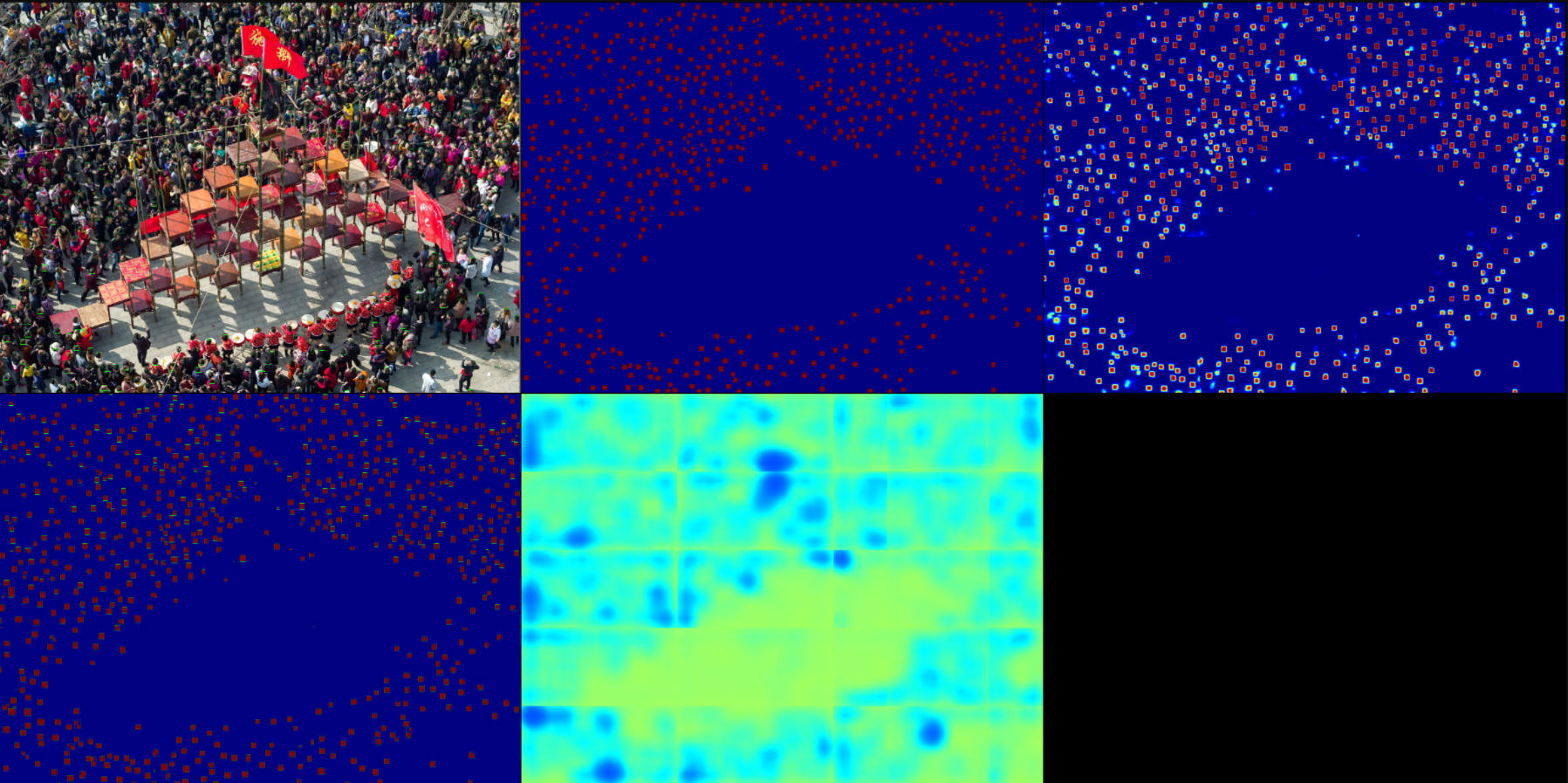This repo is the official implementation of paper: Learning Independent Instance Maps for Crowd Localization. The code is developed based on C3F.

- Testing Code (2020.12.10)
- Training Code
- NWPU (2020.12.14)
- JHU (2021.01.05)
- UCF-QNRF (2020.12.30)
- ShanghaiTech Part A/B (2020.12.29)
- FDST (2020.12.30)
- scale information for UCF-QNRF and ShanghaiTech Part A/B (2021.01.07)
-
Prerequisites
- Python 3.7
- Pytorch 1.6: http://pytorch.org .
- other libs in
requirements.txt, runpip install -r requirements.txt.
-
Code
- Clone this repo in the directory (
Root/IIM): - Download the pre-trained HR models from this link. More details are availble at HRNet-Semantic-Segmentation and HRNet-Image-Classification.
- Clone this repo in the directory (
-
Datasets
-
Download NWPU-Crowd dataset from this link.
-
Unzip
*zipfiles in turns and placeimages_part*into the same folder (Root/ProcessedData/NWPU/images). -
Download the processing labels and val gt file from this link. Place them into
Root/ProcessedData/NWPU/masksandRoot/ProcessedData/NWPU, respectively. -
If you want to reproduce the results on Shanghai Tech Part A/B , UCF-QNRF, and JHU datasets, you can follow the instructions in DATA.md to setup the datasets.
-
Finally, the folder tree is below:
-
-- ProcessedData
|-- NWPU
|-- images
| |-- 0001.jpg
| |-- 0002.jpg
| |-- ...
| |-- 5109.jpg
|-- masks
| |-- 0001.png
| |-- 0002.png
| |-- ...
| |-- 3609.png
|-- train.txt
|-- val.txt
|-- test.txt
|-- val_gt_loc.txt
-- PretrainedModels
|-- hrnetv2_w48_imagenet_pretrained.pth
-- IIM
|-- datasets
|-- misc
|-- ...
- run
python train.py. - run
tensorboard --logdir=exp --port=6006. - The validtion records are shown as follows:

- The sub images are the input image, GT, prediction map,localization result, and pixel-level threshold, respectively:

Tips: The training process takes ~50 hours on NWPU datasets with two TITAN RTX (48GB Memeory).
- Modify some key parameters in
test.py:netName.model_path.
- Run
python test.py. Then the output file (*_*_test.txt) will be generated, which can be directly submitted to CrowdBenchmark
- Modify some key parameters in
test.py:test_list = 'val.txt'netName.model_path.
- Run
python test.py. Then the output file (*_*_val.txt) will be generated. - Modify some key parameters in
vis4val.py:pred_file.
- Run
python vis4val.py.
The results (F1, Pre., Rec. under the sigma_l) and pre-trained models on NWPU val set, UCF-QNRF, SHT A, SHT B, and FDST:
| Method | NWPU val | UCF-QNRF | SHT A |
|---|---|---|---|
| Paper: VGG+FPN [2,3] | 77.0/80.2/74.1 | 68.8/78.2/61.5 | 72.5/72.6/72.5 |
| This Repo's Reproduction: VGG+FPN [2,3] | 77.1/82.5/72.3 | 67.8/75.7/61.5 | 71.6/75.9/67.8 |
| Paper: HRNet [1] | 80.2/84.1/76.6 | 72.0/79.3/65.9 | 73.9/79.8/68.7 |
| This Repo's Reproduction: HRNet [1] | 79.8/83.4/76.5 | 72.0/78.7/66.4 | 76.1/79.1/73.3 |
| Method | SHT B | FDST | JHU |
|---|---|---|---|
| Paper: VGG+FPN [2,3] | 80.2/84.9/76.0 | 93.1/92.7/93.5 | - |
| This Repo's Reproduction: VGG+FPN [2,3] | 81.7/88.5/75.9 | 93.9/94.7/93.1 | 61.8/73.2/53.5 |
| Paper: HRNet [1] | 86.2/90.7/82.1 | 95.5/95.3/95.8 | 62.5/74.0/54.2 |
| This Repo's Reproduction: HRNet [1] | 86.0/91.5/81.0 | 95.7/96.9 /94.4 | 64.0/73.3/56.8 |
References
- Deep High-Resolution Representation Learning for Visual Recognition, T-PAMI, 2019.
- Very Deep Convolutional Networks for Large-scale Image Recognition, arXiv, 2014.
- Feature Pyramid Networks for Object Detection, CVPR, 2017.
About the leaderboard on the test set, please visit Crowd benchmark. Our submissions are the IIM(HRNet) and IIM (VGG16).
We test the pretrained HR Net model on the NWPU dataset in a real-world subway scene. Please visit bilibili or YouTube to watch the video demonstration.